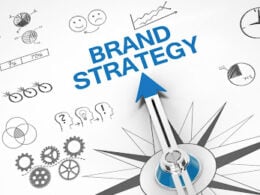Build credibility by building trust
Company brands, like individual personalities, are based on behaviors and characteristics. The stronger the characteristics, the stronger the business brand image. Over time, these company personality traits become anticipated, expected and relied upon, forming an inherent “promise” between a business and its clients. Volvo built a reputation on safety. Rolex on prestige. Walmart on low prices.

Companies have personalities just like people. The more defined the character, the more memorable the brand. Geico’s little guy coveys their affordability message “in 15 minutes or less.”
With social media on the rise, and increased transparency on the web, brands can no longer hide out, manipulate or dictate the message. Actions speak louder than tweets. This requires a new level of authenticity and commitment to a company’s core values.
What is your brand promise? Do you know it? More importantly, do your customers know it?
Most companies, (especially start ups and entrepreneurs,) in an attempt to simply get by and “make it,” lose focus and promise too many things to too many people. It’s a we-can-do-it-all mentality that fears than any “no” will lead to a loss of business — when in fact, it’s just the opposite. Saying no to incongruent clients and projects creates time and opportunity to say yes to the right ones. Common tag lines such as “No job is too big or small,” communicate little to nothing about your benefits or expertise. Much like people, companies that over promise, ultimately under deliver and disappoint, losing trust and credibility. That’s a brand fracture.
How can you avoid this trap? Start by knowing the three “C”s of brand credibility.
1. Is your message clear?
It’s tough to spread the word in advertising, marketing and social media when your message is muddy. Are you about price? Quality? Service? Innovation? Reliability? Sustainability? If your answer is “all of the above,” then it’s time to go back to square one and determine your brand message, your reason for being, your core value proposition. For Orabrush, it’s all about getting rid of the dirty tongue, and because of their singular focus on a foul-mouth character, the YouTube campaign went viral.
Orabrush brought into sharp focus the benefit of ridding the world of dirty tongues. The rest was all “word of mouth.”
In other words, what drives your organization? What are you doing when you are at your best with your best customer? Write down the ingredients to your success and then distill it and prioritize it until you have the recipe for your success. Of all the fried chicken in the world, only KFC had “eleven secret herbs and spices.” What is your “finger licking good” recipe? And as with every recipe, there is always a main ingredient. Identify it and you’ll be both clear and credible.
2. Is it consistent?
Once you know your secret recipe, make it repeatable. Consistency of experience is the hallmark of a great brand, be it Starbucks or Nordstrom. The good news is that you don’t have to be the best to be credible, you simply have to be consistent. Few would argue that McDonald’s has the best tasting hamburgers on the planet. But they have perfected consistency in their methods, systems and services – you know what you are going to get. Are you providing your customers with a consistent experience? If not, identify the break points, and address them. Repeat your successes until they become automatic.
3. Is it compelling?
It’s not enough to have a USP (Unique Selling Proposition or Unique Selling Point) if it’s not compelling. So what if you are the seventh largest web design firm east of the Mississippi? How do your core competencies benefit your clients? In other words, “what’s in it for me?” Take your clarity and consistency, combine it with something compelling and you’ll have brand magic, brand chemistry, and the power of attraction all rolled up into one. This type of focus and conviction is what drives all great brands, so put them to use to gain real traction.
An effective brand image connects on an emotional level, such as this vintage Michelin tire ad.
YouTube.com Michelin Tires “Because so much is riding on your tires.”
Make it believable by keeping it real
Now that your message is clear, consistent and compelling, take a check to make sure that it is also attainable. Your values may be rooted in social justice, but just be careful not to promise world peace. I once saw an ad that purported to know the real measure of a person, the true indicator of character and worth. They had me hooked… was it a new movement? A faith-based initiative? No, the key to life turned out to be a new type of watch. So stay with a promise that you can deliver on, one that you can build and expand upon. Answer these three questions and you’ll have true brand believers.
1. Is your brand image “right sized” for your company?
Craft a message that you can really take hold of and “own.” In my first few years of company branding, I would often say that we could create the “perfect” brand name for a new business. In an attempt to do what’s right, and meet the client’s needs, I set up an unrealistic expectation. Perfection was in the eye of the beholder, a subjective evaluation that’s beyond control. We later fine tuned the message to promise “brilliant brand marketing” which we could back up with smart rationales and client case studies. We found brilliant to be more believable, and achievable, than perfection.
Reno’s tag line form fits their brand image of big city/small town living.
2. Do you both say it AND do it?
Contrived slogans simply don’t work anymore. BP jumped the gun with their aspirational message of being “Beyond Petroleum,” which may well have been a worthy goal, but obviously fell short of the mark.
Â
It’s vital to know the difference between where you want to go as a company, and what the actual user experience is at that moment. If you state what your company provides, but don’t deliver, you break your brand promise. If you are the social media experts, with 98 Twitter followers and no recent tweets, your message will be had to believe, no matter what you say.
3. Are they your words or also those of your customers?
The mattress company Temperpedic, and a number of other retailers, are televising ads that direct viewers to their Facebook and other social media sites to hear and read what consumers are saying. It’s a bold move, but one that underscores their conviction in their product quality and customer support. These proactive brands have learned a valuable lesson. It’s not about controlling the conversation and presented a false front of perfection. It’s about listening and responding in a timely fashion. Often the most disgruntled customers are turned into raving fans. Customer praise resonates better and speaks louder than company claims.
Tempur-pedic lets their customers speak for them, inviting feedback and interaction. They utilize their television ads to drive traffic to their social media sites.
Transform your brand image into equity – where branding meets banking
The right brand image impacts the bottom line on a number of levels. It provides guidance and direction to your entire organization. You no longer waste valuable staff time chasing conflicting goals, clients and outcomes. Your employees will also begin to act as filter media, screening out incompatible clients and attracting good ones. Your company gains congruency as you become more focused and effective.
The right brand image can determine your short term direction — as well as your future industry space.
Imagine if Apple had continued to say they were a “computer company.” By realigning their brand image, that of a cool, digital lifestyle company, they are now in the league of Google and Sony (vs. their earlier competitors of Packard Bell, Compaq, Dell, Tandy and Gateway.) This shift in brand image and focus took a company, once on life support, to one that has surpassed the likes of Exxon Mobil and China Petro.
Apple has made financial news on several occasions over the last two years, at times topping Exxon Mobil and China Petro as the world’s highest valued company.
Better yet, a strong brand image helps a company maintain that magic word called “margin.” By remaining clear, consistent and compelling, you can create a space that is uniquely yours, charge a premium, and not fall into the trap of becoming a priced-based commodity.
Does your company qualify as a true brand? Would customers gladly wear your company name on a t-shirt? Would another company or industry pay a premium to license your name? Is your name synonymous with any one word or attribute? If not, set aside some time to re-examine your image and identify your true goals and objectives. By applying these proven brand principles you’ll create both believers and buyers.
Have you been able to improve your bottom line by improving your brand focus? Have you been able to make your brand message credible, believable and social? If so, share what strategies have helped to make your company shine.











